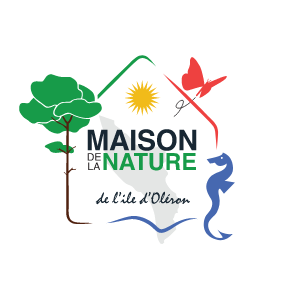Become aware of each foreshore distinctive feature throughout the department of Charente Maritime, so as to gather shellfish right, to get informed of advice and shellfish tips , according at any time with the temporary prohibition leisure shellfish collection bylaws , moreover to get basic knowledge of the shellfish, crustacean,… features
Where shellfish gathering ?
The rocky, silty or sandy foreshore
A sensible approach to gathering shellfish on any foreshore…
Caption: Green: burrowing shells collecting prohibition – Purple: protected mussels spot – Yellow: protected oysters spot – Blue: shellfish collection prohibition except of burrowing ones- Red: forbidden areas and ports.
These advices don’t undertake the liabilty of the association.
Ministry of the sea map showing local shellfish collecting rules –
Advice for Shellfish collection
Advice for Shellfish collection
- Always replace displaced rocks to protect microflora
- Always gather seaweed carefully and gently
- Always check the tide times and range before going on to the reef (range between 20-120)
- Always wear sensible closed, waterproof boots or shoes to avoid cutting your feet on the sharp reef
- Always be aware of the current weather conditions and dress appropriately
- Never go fishing alone and always tell someone where you are going
- Don’t throw anything in to the sea
- Keep an eye on the rising tide, which could become a danger
- Do not gather more than you need
Rules for Shellfish collection
Rules for Shellfish collection
- Always respect the minimum collection size of various shellfish (marked by red pointers on the pictures of shells below) and do not gather more than 5 kgs shellfish irrespective of variety (except of Spiny spider crab, European Carpet shell, Common cockle , Banded wedge shell, Venus shell).
- Only go fishing on the reef during daylight
- Only collect shellfish more than 25 meters from any granted marine breeding field, like an “écluse” * , or an oysters or mussels farming field . It is forbidden to fish neither inside “les écluses” nor in the Chassiron experiment area.
- Only fish using the permitted tools (pick of a 4 cm maximum width handle, knife of a 30 cm maximum length handle , non wire-netted rake of a 80 cm maximum length handle, carpet shell claw)
- Be aware of forbidden marine activities zones, including channels, protected beaches, harbours, Natural Reserves like the Moëze- Oléron Reserve and other potentially contaminated areas
- It is forbidden to sell your shellfish harvest
* Definition
Ecluse: A manmade wall usually built on a reef to trap fish at the lowering tide. A traditional way of fishing dating from Middle Ages.
Oléron Island : Official shellfish collection bylaw
Silty foreshore shellfish collection
Brown Shrimp (French name : Crevette grise)
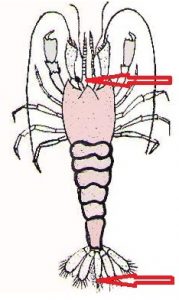
Minimum size: 3 cm
Shellfish tip: The living shrimp appears transparent. Its minimum size is measured from the rostrum to the end of the tail. It can be caught in estuaries during final ebb of water at low tide.
Scientific name: Crangon crangon
Common cockle (French name : Coque/Sourdon)
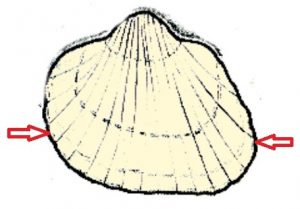
Minimum size: 2,7 cm
Maximum quantity : From january 1st 2018, 2 kgs each shellfisher and tidal are authorized.
Shellfish tip: The common cockle lives in sandy or silty-sandy areas. To catch it, look for two little holes close together on the surface of the mud (these allow two siphons to oxygenate the shell during low tide). Don’t forget to leave the shells to disgorge in sea water for a few hours before eating them, to get rid of any sand or silt.
Scientific name: Cerastoderma edule
Prohibited burrowing shells gathering area : Gathering Carpet shell, Cockle, Razor shell and Banded wedge shell is prohibited beyond the western mouth of the River Seudre, in the southern part of the Coureau d’Oléron, so as beyond the northerly coast of the Chevanceaux headland in the Ré island.
Japanese oyster (French name : Huître creuse/Huître japonaise)
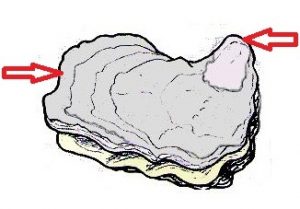
Minimum size: 5 cm
Shellfish tip: We can only find left overs from oysters breeding parks. The Japanese oysters can only be fished at more than 25 meters from these cultivating areas.
Scientific name: Crassostrea gigas
Listed natural oystersfields : Contact the local authorities. By the 6th of september 2016 Official Region bylaw, gathering Japanese oysters (Crassotrea gigas) and Flat or native oysters ( Ostrea edulis) can be achieved only on the Jamblet and Tridoux fields (Aix island), the Palles and Toureau ones, the Lauzières field, the La Menoise field (Angoulins) from february 1st to november 30th each year. It can be achieved too on the Chauveau field from february 1st to may 15th each year. It must be done between sunrise and sunset. This handgathering can also be done thanks to a 4 cm maximum width pick. Up to 5 kgs each per tide, gathering oysters must be done further than 25 m from any marine breeding field. Only armcarrying back.
Sandy foreshore shellfish collection
European Carpet shell (French name :Palourde européenne)
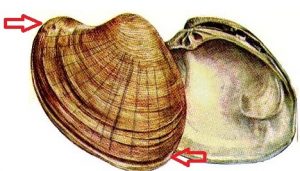
Minimum size: 4 cm
Maximum quantity : From january 1st 2018, 200 pieces each shellfisher and tidal are authorized.
Shellfish tip: The Carpet shell lives in sandy or silty-sandy areas. To catch it, look for two little holes close together on the surface of the mud (these allow two siphons to oxygenate the shell during low tide). Don’t forget to leave the shells to disgorge in sea water for a few hours before eating them, to get rid of any sand or silt. The European carpet shell is quite wide-spread unlike the Japanese Carpet shell which has to be bred here. The Japanese Carpet shell is an introduced species which tends to take over at the expense of the native European species. The hinge of the European Carpet shell is not as prominent as the Japanese one. The inner valves of the European Carpet shell are not purple spotted.
Scientific name: Ruditapes deccussatus
Prohibited burrowing shells gathering area : Gathering Carpet shell, Cockle, Razor shell and Banded wedge shell is prohibited beyond the western mouth of the River Seudre, in the southern part of the Coureau d’Oléron, so as beyond the northerly coast of the Chevanceaux headland in the Ré island.
Banded wedge shell (French name: Donace/Telline/Luisette)
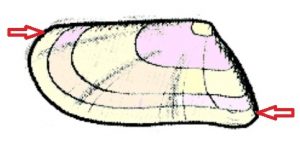
Minimum size: 2,5 cm
Maximum quantity : From january 1st 2018, 2 kg each shellfisher and tidal are authorized.
Shellfish tip: Scrape the sand at the low tide mark as the sea descends. Be aware that decent sized examples of these shellfish are not found in great quantities these days due to previous overfishing. Don’t forget to leave the shells to disgorge in sea water for a few hours before eating them, to get rid of any sand.
Scientific name: Donax Vittatus
Prohibited burrowing shells gathering area : Gathering Carpet shell, Cockle, Razor shell and Banded wedge shell is prohibited beyond the western mouth of the River Seudre, in the southern part of the Coureau d’Oléron, so as beyond the northerly coast of the Chevanceaux headland in the Ré island.
Common cockle (French name: Coque/Sourdon)

Minimum size: 2,7 cm
Maximum quantity : From january 1st 2018, 2 kg each shellfisher and tidal are authorized.
Shellfish tip: The Common cockle lives in sandy or silty-sandy areas. To catch it, look for two little holes close together on the surface of the mud (these allow two siphons to oxygenate the shell during low tide). Don’t forget to leave the shells to disgorge in sea water for a few hours before eating them, to get rid of any sand or silt.
Scientific name: Cerastoderma edule
Prohibited burrowing shells gathering area : Gathering Carpet shell, Cockle, Razor shell and Banded wedge shell is prohibited beyond the western mouth of the River Seudre, in the southern part of the Coureau d’Oléron, so as beyond the northerly coast of the Chevanceaux headland in the Ré island.
Japanese Carpet shell (French name : Palourde japonaise )
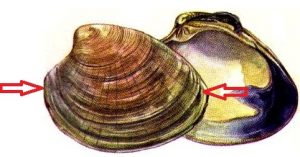
Minimum size: 3,5 cm
Maximum quantity : From january 1st 2018, 200 pieces each shellfisher and tidal are authorized.
Shellfishy tip: The Japanese carpet shell lives in sandy or silty-sandy areas. To catch it, look for two little holes close together on the surface of mud (these allow two siphons to oxygenate the shell during low tide). Don’t forget to leave the shells to disgorge in sea water for a few hours before eating them, to get rid of any sand or silt. The Japanese carpet shell has to be bred here, unlike the European carpet shell which is quite wide-spread. The Japanese carpet shell is an introduced species which tends to take over at the expense of the native European species. The hinge of the Japanese carpet shell is quite prominent unlike the European one. The inner valves of the Japanese carpet shell are purple spotted.
Scientific name: Ruditapes philippinarum
Prohibited burrowing shells gathering area : Gathering Carpet shell, Cockle, Razor shell and Banded wedge shell is prohibited beyond the western mouth of the River Seudre, in the southern part of the Coureau d’Oléron, so as beyond the northerly coast of the Chevanceaux headland in the Ré island.
Otter shell (French name : Lutraire )
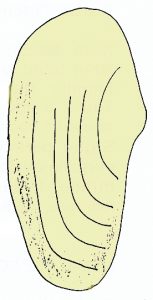
Minimum size: No regulatory minimum size
Shellfish tip: Found during the biggest low tides. The Otter shell tends to live deep in the sand.
Scientific name: Lutraria lutraria
Razor shell (French name : Couteau/Coutelet)

Minimum size: 10 cm
Shellfish tip: The Razor shell digs 2 little holes side by side, which looks like a number 8 on the surface. By putting salt into these holes, the Razor shell feels in a wrong way that the tide is coming back up, so it resurfaces making it easier to catch. Razor shells are caught during the biggest tides.
Scientific name: Ensis / Solen marginatus, Ensis siliqua, Pharus legumen
Prohibited burrowing shells gathering area : Gathering Carpet shell, Cockle, Razor shell and Banded wedge shell is prohibited beyond the western mouth of the River Seudre, in the southern part of the Coureau d’Oléron, so as beyond the northerly coast of the Chevanceaux headland in the Ré island.
Sand gaper (French name : Mye des sables/Bec de jar )
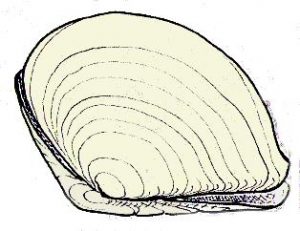
Minimum size: No regulatory minimum size
Shellfish tip: Found during the biggest low tides. The Sand gaper tends to live deep in the sand.
Scientific name: Mya arenaria
Venus shell (French name : Praire )
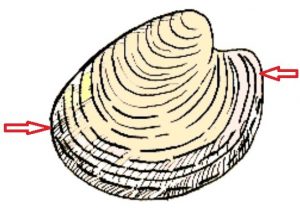
Minimum size: 4,30 cm
Maximum quantity : From january 1st 2018, 3 kg each shellfisher and tidal are authorized.
Shellfish tip: It can be caught in large grained sand.
Scientific name: Venus verrucosa
Rocky foreshore shellfish collection
Common Limpet (Patelle/Bernique/Chapeau chinois/Jambe)
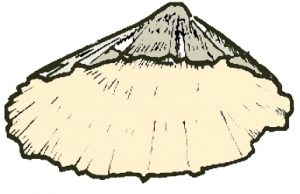
Minimum size: No regulatory minimum size
Shellfish tip: It can be taken off the rocks with a knife.
Scientific name : Patella vulgata
French names: Patelle, Bernique,Chapeau chinois, Jambe
Common Periwinkle (French name: Bigorneau)
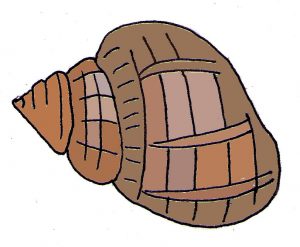
Minimum size: No regulatory minimum size
Shellfish tip: You can catch periwinckles under rocks or hidden in seaweed. Go for the biggest specimens. The periwinckle has a black circular sharp without any pearly marks on the shell.
Scientific name: Littorina littorea
Common mussel (French name: moule)
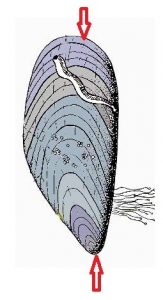
Minimum size: 4 cm
Shellfish tip: Common mussels attach themselves to the rocks with their own filaments.
Scientific name: Mytilus edulis
Vernacular French name: moule
Listed natural musselfield : Gathering mussels runs all the year long excepted on the listed natural musselfield in the southern part of the Coureau d’Oléron, where it is prohibited.
Common prawn (French name: crevette Bouquet/crevette rose)
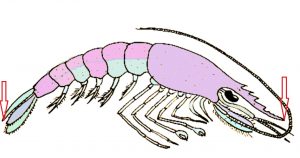
Minimum size: 5 cm
Shellfish tip: This prawn looks transparent in water. Measure its minimum size from rostrum to tail end.
Scientific name: Palaemon serratus
Edible Crab (French name: Tourteau/Dormeur/Bourse)
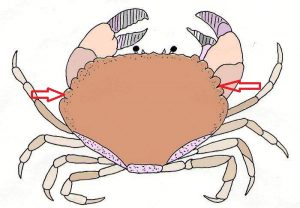
Minimum size: 13 cm
Shellfish tip: You can catch Edible crabs during the biggest tides in the holes in the rocks. It is forbidden to catch females which carry roe.
Scientific name: Cancer pagurus
Japanese oyster (French name: Huître creuse/Huître japonaise)

Minimum size: 5 cm
Shellfish tip: The wild Japanese oyster is well attached to the rocks. It can be taken off with a strong knife. Its minimum size has to be measured from hinge to extremity.
Scientific name: Crassostrea gigas
Vernacular French name: Huître creuse / Huître japonaise
Listed natural oystersfields : Contact the local authorities. By the 6th of september 2016 Official Region bylaw, gathering Japanese oysters (Crassostrea gigas) and Flat or Native Oysters (Ostrea edulis) can be achieved only on the Jamblet and Tridoux fields (Aix island) , the Palles and Toureau ones, the Lauzières field, the La Menoise field ( Angoulins) from february 1st to november 30th each year. It can be achieved too on the Chauveau field from february 1st to may 15th each year. It must be done between sunrise and sunset. This handgathering can also be done thanks to a 4 cm maximum width pick. Up to 5 kgs each per tide, gathering oysters must de done further than 25 m from any marine breeding field. Only armcarrying back.
Sea Urchin (French name : Oursin)
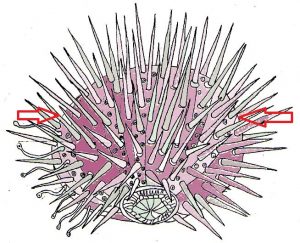
Minimum size: 4 cm without spines
Shellfish tip: Sea Urchins grip onto rocks and are often hidden among seaweed, shells, etc. Their minimum size is measured without their spines.
Scientific name: Paracentrotus lividus
Spiny spider crab (French name: Araignée de mer/Gourgale)
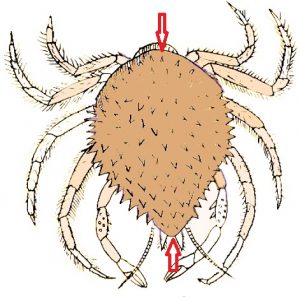
Minimum size: 12 cm
Maximum Quantity : From January 1st 2018, 6 pieces each shellfisher and tidal are authorized.
Shellfish tip: The Spiny spider crab is found in seaweed during the biggest tides. Don’t harvest females bearing roe.
Scientific name: Maia squinado
Trochidae (French name: Troque)
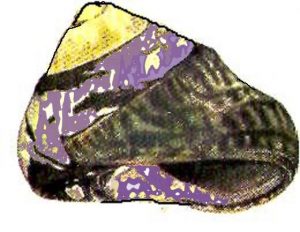
Minimum size: No regulatory minimum size
Shellfish tip: Find trochidae under rocks or hidden in seaweed. Go for the biggest specimens. Trochidae is different from periwinckle in that it has some pearly marks on the shell.
Scientific name: Monodonta lineata / Phorcus lineatus
Variegated Scallop (French name: Pétoncle)

Minimum size: 4 cm
Shellfish tip: Variegated scallop is attached to the rocks by its own filaments.
Scientific name: Chlamys varia
Velvet crab (French name: Bataillet/Etrille)
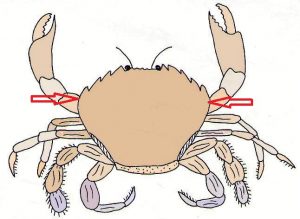
Minimum size: 6,5 cm
Shellfish tip: Find Velvet crabs during the biggest tides in holes in the rocks.
Scientific name: Necora puber
